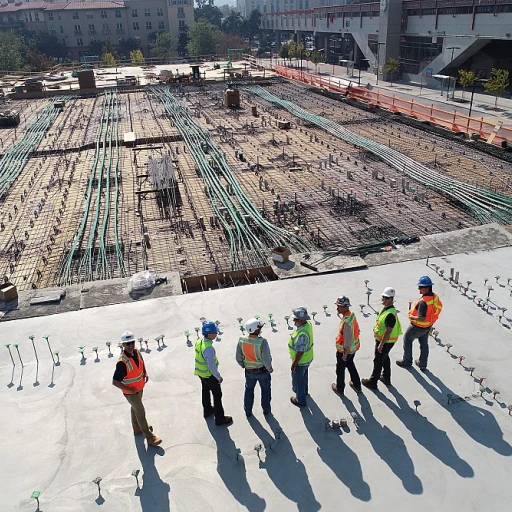
The Essence of Employee Development
The Fundamental Role of Employee Development
In the intricate web of work-life balance, employee development stands as a pivotal element. For organizations like UPS, harnessing the potential of development is paramount not only for personal growth but also to foster a thriving team dynamic. Employee development is about nurturing the individual's skills and potential, aligning them with the company's overarching goals. It's a process that transcends mere performance reviews and dives into tailored plans aimed at bolstering both employee engagement and effectiveness.
Managers play a crucial role here. By providing continuous support and real-time feedback, a foundation for a more adaptive development process is established. This comes with numerous techniques, including regular check-ins that replace traditional annual reviews. Instead of waiting for a long performance review process, employees receive instant feedback, enabling them to improve performance rapidly.
Development plans crafted by skilled leaders become action blueprints for high performers, not just within UPS but in any company. Structured management systems ensure that both individuals and team members are steering towards growth and excellence. This systematic approach helps in recognizing potential leaders and high performance, aligning well with strategic company objectives.
Understanding the difference between developing skills and simply managing performance leads to a more meaningful impact on an organization's growth. For those looking to delve deeper into fostering a unified sense of purpose and growth within teams, exploring effective team-building exercises can also enhance development and engagement.
Performance Management: A Different Perspective
Exploring the Dynamics of Employee Performance Management
Performance management is an intricate process, encompassing a range of elements designed to evaluate and enhance employee performance within the organizational framework. Unlike employee development, which focuses on personal and professional growth, performance management serves as a tool for gauging an individual's contribution to the company's goals. The cornerstone of effective performance management lies in real-time feedback and regular check-ins. This approach allows managers to address any issues promptly, ensuring that team members stay on track. High performers are often identified and nurtured through this continuous feedback mechanism, which is a departure from the traditional annual reviews that many companies still rely upon. Managers and leaders play a crucial role in this management process. They engage in performance reviews that help set clear expectations and formulate action plans tailored to employees' strengths and areas for improvement. By facilitating open communication, performance management opens windows to enhance employee engagement and encourage high performance. It's not just about metrics; it’s about creating a work environment where the team and individuals can thrive. Leadership's involvement in performance management is essential. They don’t just enforce policies—they provide the guidance and support necessary for employees to succeed. This collaborative approach creates a company culture that values development just as much as it values meeting objectives. The time spent on building these relationships between team leaders and members significantly impacts the overall performance of individuals and the organization. For organizations striving to maintain a robust management system, balancing the scales between development and performance is crucial. This can lead to improved employee performance, fostering a motivated and committed workforce. To better understand how effective leadership contributes to achieving this balance, visit crafting effective leadership statements for better work-life balance. Here, you'll learn more about implementing strategies that nurture an empowering work atmosphere.Why Confusion Arises Between Development and Performance Management
Unraveling the Overlap and Misunderstandings
Development and performance management are often mistakenly lumped together. It is essential to understand where the confusion lies. Both processes involve feedback and engagement, yet they have differing objectives. One reason for this confusion is the incorporation of "management" in both terms, which inadvertently suggests they are similar processes. Development focuses on the growth and progression of employees, emphasizing learning opportunities and personal advancement. This process encourages employees to set action plans, upskill, and prepare for future challenges. The leadership aims to mentor individuals, identifying potential leaders and helping them evolve. In contrast, performance management is primarily about evaluating and maintaining high performance levels through structured processes. It includes regular performance reviews and real-time feedback sessions, aligning employee performance with the company’s overarching goals. Leaders and team members engage in constructive check-ins to ensure everyone is on track and areas for improvement are promptly addressed. Another source of confusion arises from the overlapping tools used in both domains. Both development and performance management utilize feedback mechanisms, annual reviews, and employee engagement strategies to achieve their distinct goals. For a company, particularly in environments like that of UPS, improper differentiation can lead to misguided expectations. Employees may perceive development reviews as mere performance evaluations, causing dissatisfaction or even reduced morale. For organizations to thrive and foster a healthy work-life balance, it's crucial to differentiate clearly between these processes. Educating employees and managers on the specific objectives and benefits of each can open windows to more targeted approaches, improving performance and employee satisfaction. For more in-depth insights, learn about strategies on boosting associate engagement.Impact on Work-Life Balance
How Misjudgment Affects Work-Life Balance
Understanding the nuances between development and performance management is crucial in maintaining a healthy work-life balance for employees. When these concepts blur, the consequences extend beyond workplace confusion and directly impact personal time and energy levels. The stakes of proper differentiation are high. Consider how feedback mechanisms play a role. Regular performance reviews and real-time feedback are structured differently from development check-ins. With performance management, feedback is often tied to assessing high-performance metrics, focusing on near-term goals and annual reviews. In contrast, development centers on long-term growth and employee engagement, fostering leadership skills over time. When leaders or managers incorrectly lump development into the performance review process, employees may feel pressured into high achiever roles, where they are constantly evaluated. This pressure can lead to overtime, reducing the personal time critical for a balanced lifestyle. The management system must clearly separate these processes, enabling employees to thrive both professionally and personally. High performers, while often seen as company assets, are especially vulnerable to these pressures. Without clear differentiation, they may struggle to switch off from work, affecting their mental health and overall job satisfaction. It's essential for management to offer distinct pathways for skill enhancement without the added stress of performance evaluation pressures. Opens a window for leaders and team members to prioritize action plans that improve performance while fostering personal development. Such clarity ensures employee engagement, curbing the risk of burnout, and promoting a balanced lifestyle. Clear processes cater not only to company goals but also to the personal aspirations of each employee, guarding their work-life harmony.Strategies for Clear Differentiation
Strategies for Distinguishing Development and Performance Management
In any organization, clarity between employee development and performance management can significantly impact both productivity and morale. To differentiate these essential concepts, a few actionable strategies can be implemented.- Regular Check-Ins: Structured time for feedback helps employees make sense of their development outside their performance reviews. Leaders and managers should engage in consistent check-ins, allowing employees to voice their feelings and progress.
- Clear Communication: Opening the window for transparent communication between management and team members can demystify processes. A well-informed team is more empowered to focus on development without confusing it with performance evaluation.
- Leverage Technology: Utilizing advanced management systems to store and communicate information about employee performance and development plans can lead to a clear separation of the two processes. Leaders should encourage team members to click share their goals and progress with the broader team, fostering understanding and integration.
- Tailored Action Plans: Designing individual action plans focused on employee growth encourages high performers to understand their development priorities without misaligning with their performance metrics.
- Employee Engagement Initiatives: By investing time in activities and initiatives aimed at improving employee engagement, companies can reinforce the difference between development and performance management, creating a culture of continual learning and growth.
- Training for Managers: Providing formal training for employees managers on these differences ensures they are well-equipped to support their teams effectively.
Case Study: UPS Approach to Development and Performance
UPS's Dual Approach to Employee Growth
At UPS, the distinction between development and performance management is not just theoretical; it is a practical, everyday reality. The company has implemented a robust management system that emphasizes both employee development and performance management as separate yet complementary processes.
Employee Development: A Continuous Journey
UPS places a strong emphasis on continuous employee development. This approach is designed to foster high performance by providing employees with the tools and resources they need to grow. Development at UPS is not a one-time event but a continuous journey that involves regular check-ins and real-time feedback. Managers and leaders are encouraged to engage in open dialogues with team members, focusing on long-term growth and skill enhancement.
Performance Management: Structured and Objective
In contrast, performance management at UPS is more structured and objective. It involves regular performance reviews and the use of performance metrics to assess employee performance. The management process includes annual reviews and time feedback sessions, where employees receive constructive feedback aimed at improving performance. This structured approach helps in identifying high performers and creating action plans to address any performance gaps.
Impact on Work-Life Balance
By clearly distinguishing between development and performance management, UPS helps employees maintain a better work-life balance. Employees don’t feel overwhelmed by constant performance evaluations, as development is seen as a supportive process rather than a punitive one. This balance opens a window for employees to engage more deeply with their work without the stress of constant scrutiny.
Leadership and Management Support
Leaders and managers at UPS play a crucial role in this dual approach. They are trained to provide constructive feedback and support employee engagement. The company believes that effective leadership is key to fostering a positive work environment where employees feel valued and motivated.
Conclusion: A Model for Success
UPS's approach to development and performance management serves as a model for other organizations aiming to improve employee engagement and work-life balance. By treating these processes as distinct yet interconnected, UPS ensures that its employees are both high performers and satisfied team members.












